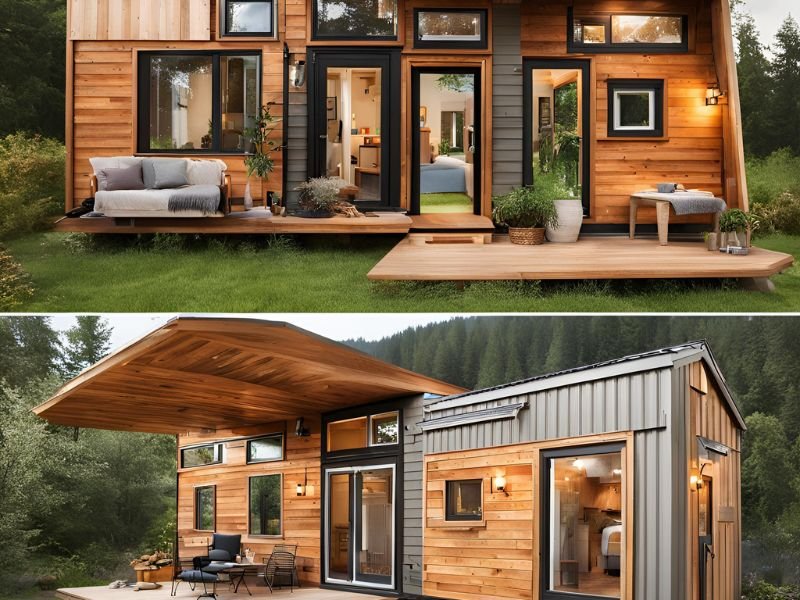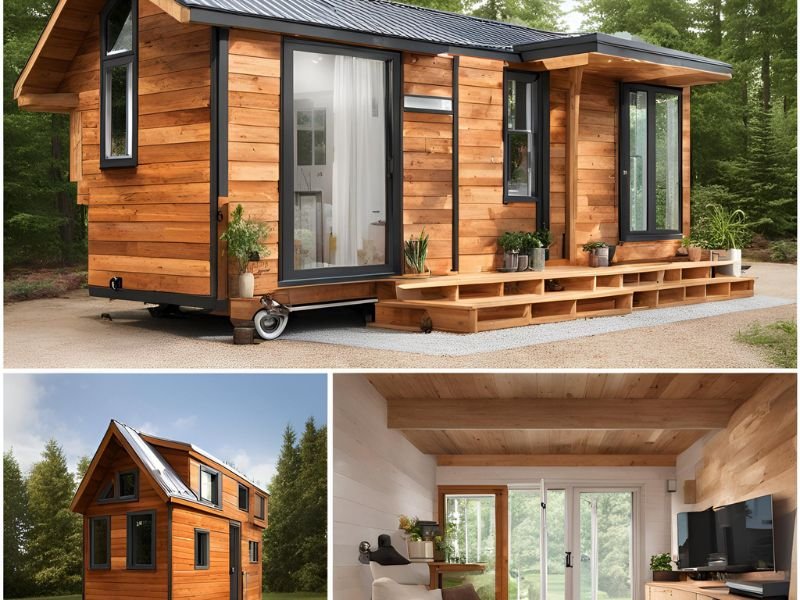When building sustainable tiny homes, opt for eco-friendly materials, maximize natural light, plan the space efficiently, use renewable energy sources, conserve water, manage waste sustainably, and prioritize energy-efficient appliances. These practices are essential for creating an environmentally friendly and efficient living space.
Key Takeaways
- Choose eco-friendly materials for construction.
- Maximize natural light and energy efficiency.
- Utilize efficient space-saving solutions.
- Incorporate renewable energy sources like solar panels.
- Implement water conservation and waste management systems.
Choosing Eco-Friendly Materials

Are you wondering how to select eco-friendly materials for your sustainable tiny home?
When it comes to insulation, opt for recycled insulation made from materials like denim or cellulose. Not only does this help reduce waste, but it also provides effective thermal regulation for your tiny home.
Another important eco-friendly choice is installing solar panels on your roof. Solar panels harness renewable energy from the sun, reducing your reliance on traditional power sources and lowering your carbon footprint.
Maximizing Natural Light
To maximize natural light in your tiny home, consider strategic window placements and the addition of skylights for increased brightness. These elements can enhance the aesthetic appeal of your space and reduce the need for artificial lighting during the day.
Window Placement
Maximizing natural light in tiny homes is essential for creating a bright and spacious feel in limited space. When considering window placement, it’s vital to strategically position windows to optimize interior design and energy savings.
Placing windows near workstations and seating areas can enhance the overall aesthetic appeal of the space, making it feel more inviting and open. By allowing natural light to flood into your tiny home, you can reduce the need for artificial lighting during the day, leading to significant energy savings.
Additionally, well-placed windows can create a seamless connection between the indoor space and the outdoors, making your tiny home feel more expansive and airy. Careful window placement is a simple yet effective way to enhance the functionality and comfort of your sustainable tiny home.
Skylights for Brightness
Positioning skylights strategically can greatly enhance the brightness and spacious feel of your tiny home. Skylights offer numerous benefits, such as providing natural light advantages that can reduce the need for artificial lighting during the day.
When considering the installation of skylights, it’s important to factor in the design of your tiny home to maximize their effectiveness. Skylights not only brighten up the space but also create a connection to the outdoors, making your living area feel more open and airy.
Proper installation of skylights can also contribute to energy efficiency by reducing the reliance on electric lighting. By incorporating skylights into your tiny home design, you can create a well-lit and welcoming environment that promotes sustainability.
Read More:
- 10 Budget-Friendly DIY Tiny Home Projects”
- Optimizing Space in Tiny Homes: 7 DIY Tips
- Why Opt for DIY Projects in Tiny Homes?
Efficient Space Planning
When designing your tiny home, consider utilizing space-saving furniture ideas. This can include items like foldable tables, wall-mounted desks, and storage ottomans. These pieces can help you make the most out of limited space without sacrificing functionality.
Creating multi-functional room layouts is another important aspect of tiny home design. For example, a living room that doubles as a guest bedroom with a pull-out sofa or a loft bed that provides sleeping space while freeing up floor space for other activities. By combining different functions within the same area, you can optimize the use of each room in your tiny home.
Implementing storage optimization tips is crucial for keeping your tiny home organized and clutter-free. Use vertical storage solutions like shelves and cabinets to maximize wall space. Consider furniture with built-in storage compartments, such as beds with drawers or ottomans that open up to reveal hidden storage. By strategically placing storage options throughout your tiny home, you can ensure that every item has its place and that your living space remains tidy and functional.
These strategies can help you make the most out of every square foot and guarantee that your tiny home feels comfortable and functional. Efficient space planning is key to maximizing the potential of your compact living space.
Space-Saving Furniture Ideas
To optimize your tiny home’s space, consider incorporating multifunctional furniture pieces that serve dual purposes. Look for creative storage solutions and compact designs that maximize functionality without taking up unnecessary space.
Utilize furniture that can transform or be easily stored when not in use, such as murphy beds with built-in storage, ottomans that double as coffee tables, or dining tables that can fold down against the wall.
Choose sofas with hidden compartments for blankets or pillows, and consider wall-mounted shelves or cabinets to keep items off the floor.
Multi-Functional Room Layouts
Consider arranging your tiny home’s layout to incorporate multifunctional spaces that maximize efficiency and utilize every available inch of space.
Furniture versatility is key in achieving this goal; opt for pieces that can serve multiple purposes, such as a sofa that transforms into a bed or a table with storage compartments.
Room functionality should be at the forefront of your design, ensuring that each area serves a distinct purpose while still being adaptable.
Creative storage solutions, like hidden cabinets or wall-mounted shelves, can help keep your space organized and clutter-free.
Embrace versatile layouts that allow for smooth shifts between different activities, making the most out of your limited square footage.
Storage Optimization Tips
Efficient space planning in your tiny home involves optimizing storage effectively to maximize functionality and minimize clutter. To make the most of your limited space, consider incorporating hidden compartments into your furniture pieces. Utilize under-bed storage, secret cabinets behind panels, or drawers beneath staircases. These hidden storage solutions help keep your belongings organized and out of sight.
Additionally, implementing vertical shelving can greatly increase your storage capacity. Install tall bookshelves or cabinets to make use of the vertical space in your tiny home. By thinking creatively about storage and utilizing hidden compartments along with vertical shelving, you can optimize your space efficiently and maintain a clutter-free living environment.
Incorporating Renewable Energy Sources

When looking to integrate renewable energy sources into your sustainable tiny home, begin by evaluating your energy needs and available resources.
Solar panels and wind turbines are popular options for harnessing renewable energy. Solar panels can be installed on the roof of your tiny home to capture sunlight and convert it into electricity. They’re efficient and low maintenance, providing a consistent source of power.
Wind turbines, on the other hand, can be a great addition if your tiny home is located in a windy area. By harnessing the power of the wind, these turbines can generate electricity to supplement your energy needs.
Consider the climate and surroundings of your tiny home to determine the most suitable renewable energy source for you.
Water Conservation Strategies
To maximize water efficiency in your sustainable tiny home, implement smart plumbing fixtures and practices. Consider incorporating greywater recycling and rainwater harvesting systems to reduce water wastage. These systems allow you to reuse water from sinks, showers, and laundry for purposes like watering plants or flushing toilets.
Additionally, installing low flow fixtures such as faucets and showerheads can greatly decrease water consumption without compromising functionality. Another water-saving option is using composting toilets, which require little to no water for operation.
Implementing Sustainable Waste Management
Consider incorporating waste separation bins and a composting system into your sustainable tiny home to effectively manage and reduce environmental impact. Composting toilets are a great eco-friendly alternative to traditional flush toilets, minimizing water usage and producing nutrient-rich compost for your garden. Recycling systems further aid in waste management by sorting materials like paper, plastic, glass, and metal for proper disposal or repurposing. Implementing these waste management practices not only reduces landfill waste but also promotes a more sustainable lifestyle in your tiny home.
| Waste Management Strategies | Benefits | Implementation |
| ————————– | ——– | ————– |
| Composting Toilets | – Minimize water usage
- Produce nutrient-rich compost | Install composting toilet systems |
| Recycling Systems | – Proper disposal of recyclable materials
- Reduce landfill waste | Set up recycling bins for different materials |
Prioritizing Energy-Efficient Appliances
Invest wisely in energy-efficient appliances for your sustainable tiny home to decrease electricity consumption and lower utility costs.
When selecting appliances, opt for energy-efficient lighting fixtures like LED bulbs, which use much less energy than traditional incandescent bulbs.
Additionally, consider investing in smart thermostats that can regulate your home’s temperature more effectively, saving energy by adjusting settings based on your habits and preferences.
By prioritizing energy-efficient appliances such as these, you can reduce your environmental impact and save money on electricity bills in the long run.
Making these smart choices won’t only benefit the environment but also contribute to a more sustainable and cost-effective lifestyle in your tiny home.
Conclusion
You’ve learned the best practices for sustainable tiny homes. By choosing eco-friendly materials, maximizing natural light, and incorporating renewable energy sources, you’re basically creating a mini paradise on Earth.
With efficient space planning, water conservation strategies, and sustainable waste management, your tiny home will be an eco-warrior’s dream come true.
And don’t forget those energy-efficient appliances – your tiny home will be so sustainable, Mother Earth will thank you daily!
Read More:
